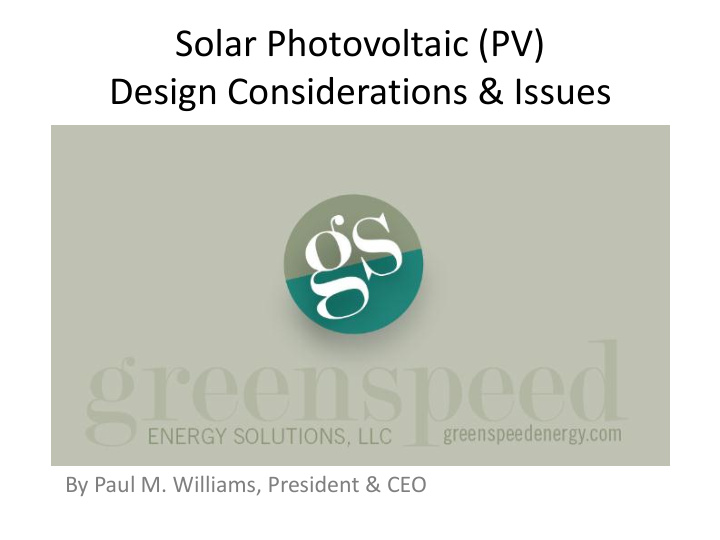



Solar Photovoltaic (PV) Design Considerations & Issues By Paul M. Williams, President & CEO
NEC – Article 690 Solar Photovoltaic (PV) Systems The article consists of eight chapters. Chapters 2 through 4 most applicable for solar array design
Article 690-Solar Photovoltaic Systems I. General II. Circuit Requirements III. Disconnecting Means IV. Wiring Methods V. Grounding VI. Marking VII. Connection to Other Sources VIII. Storage Batteries Systems Over 600 Volts
Article 690-Solar Photovoltaic Systems II. Circuit Requirements Voltage Correction Factor for Crystalline and Multi-crystalline Silicon Modules. Must correct for manufacturer's rated Voc (open-circuit voltage) for ambient temperature.
Article 690-Solar Photovoltaic Systems II. Circuit Requirements Circuit Sizing and Current – The maximum current shall be the sum of parallel module rated short-circuit currents multiplied by 125 percent. This 125 percent requirement is in addition to the 125 percent factor required by 690.8(B).
Article 690-Solar Photovoltaic Systems III. Disconnecting Means • Fused DC disconnects • Visible load break of Positive and Negative at combiner box • AC Disconnect at Interconnection
Solar PV projects may be complicated Other trades may be necessary…. Structural – roof load Mechanical – connections Civil – ground mounted arrays Architectural – aesthetics & design Security – valuable assets IT – Web monitoring, Data Acquisition System
Reference: http://www.mikeholt.com/instructor2/img/product/pdf/11SOLDVDQ100-1099-sample.pdf Solar PV Basics
Solar PV Basics – DC to AC Derate factors Reference: http://www.mikeholt.com/instructor2/img/product/pdf/11SOLDVDQ100-1099-sample.pdf
Solar PV Basics • Solar module or panels • Mounting – rail or racking I. Roof mounted II. Ground mounted III. Fixed tilt or tracking • Strings – panels connected in series • Combiner Box(CB) – strings connected in parallel
Solar PV Basics • Re-Combiner box – paralleling upstream CB • Inverters – power electronics converting DC to AC. I. Grid Tied II. Off-Grid or Island • Interconnection – Connection point to utility grid • Battery banks
Solar PV Basics • Site selection – large area • Orientation – True South • Tilt/Azimuth • Shading? Shading causes panels to act as “short circuit” to prevent damage, therefore less power output.
“Lego designs” Two Schools of Thought
Centralize Inverter Design • Example of 500 KW Centralized Inverter • Typical utility scale with interconnection voltage greater than 600 volts • String Design • Circuit sizing • Combiner Box This 500KW “Lego block” , or sub array, can be duplicated “x” times to increase PV array size. IE: 2MW is four sub arrays interconnected
1.2 MW – Centralize Inverter
2.2 MW – Centralize Inverter
2.2 MW – Centralize Inverter
De-centralize Inverter Design • Example using 10kW de-centralized Inverter • Typical utility scale with interconnection voltage less than 600 volts (both single or three phase) • String Design • Circuit sizing • Combiner Box This smaller 10kW “ L ego block”, or sub array, can be duplicated “x” times to increase PV array size. IE: 2MW is 200 sub arrays interconnected
50 kW – de-centralize Inverter
2.2 MW, 382 SMA Sunny Boy 6 kW Inverters. Vermont Solar Farm, Burlington, Vermont
De-centralize Inverter Design - Microinverters • Potentially Less labor to install • Higher initial cost • Potentially higher 20 year maintenance cost • Monitor each module • Potentially higher energy yield
Mounting Issues – Ground • Soil condition. Piles, footings or auger style • Shading – adjacent buildings, trees, structures • Fencing for safety and security • Fix tilt or tracking
Mounting Issues – Roof • Roof mounted issues - getting home runs from CBs to the Centralized inverter. Or several smaller runs from the de- centralized inverter. Minimize DC run, versus maximizing AC runs • Flat roof, ballasted - require structural engineer to perform load analysis, roof condition, age?, etc. • Tilted metal roof - standing seam: off-set using rail versus S-5! clamp Better ventilation/air flow; easier cable install • Tilted metal rood - corrugated: rail to the peaks; minimize roof penetrations - ROOF PENETRATIONS! always an issue. • Safety - safety barrier; maximum weight of personnel; designated walk-ways; two means of egress; skylights
Solar PV Market - Georgia • Georgia Power – Advance Solar Initiative 210 MW • IRS allows 30% Investment Tax Credit (ITC) • Favorable treatment for depreciation. Accelerated 5 year depreciation, with 50% bonus in first year • Georgia has plenty of annual sun! Approx 13% less than Southern California • Land is cheaper than other parts of the country – SoCal or NJ.
Solar PV Market Trends • Environmental – emissions • Electric Vehicles – may increase residential use of power and grid impact • Cost of power increasing versus Cost of PV decreasing • Increasing Demand
Solar Photovoltaic (PV) Questions? By Paul M. Williams, President & CEO
Recommend
More recommend